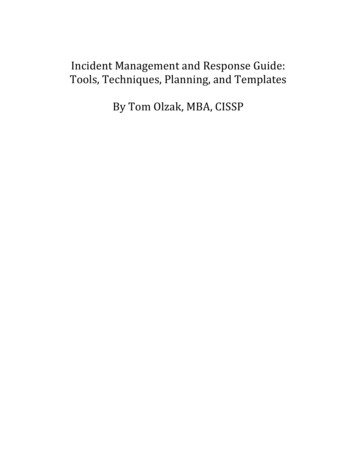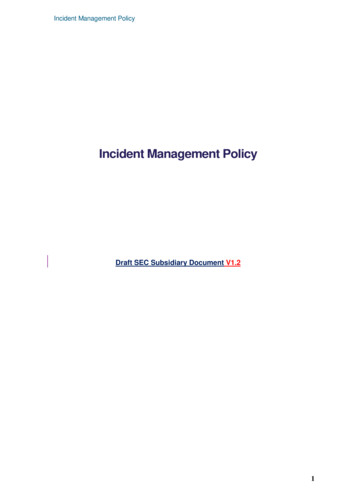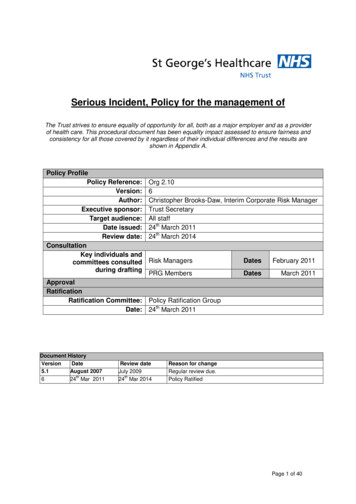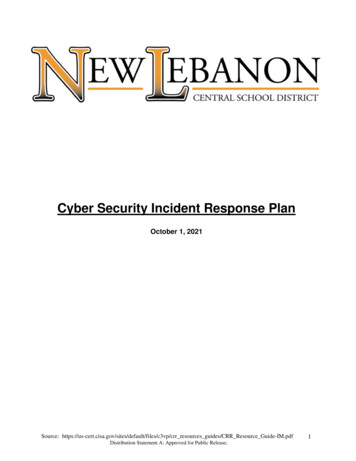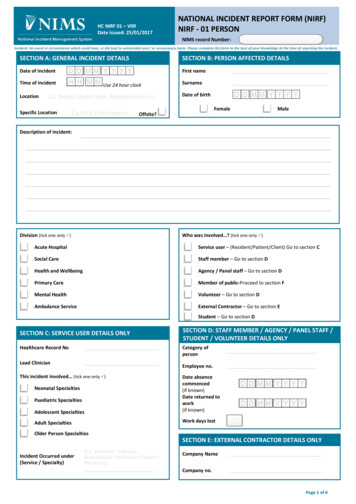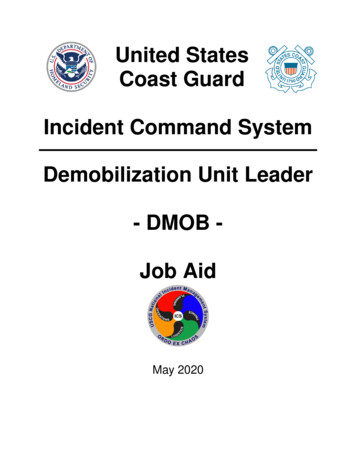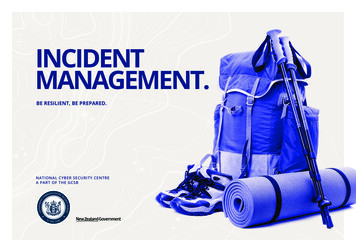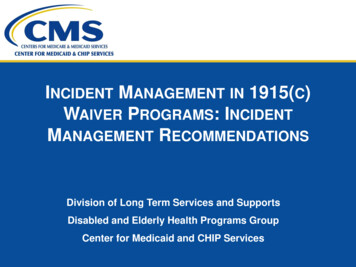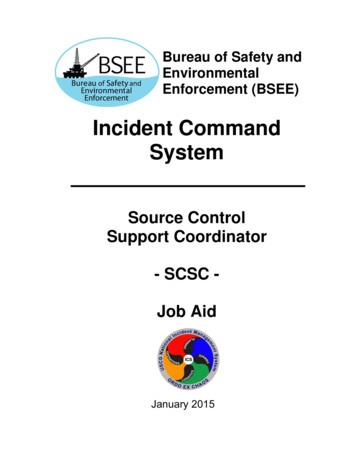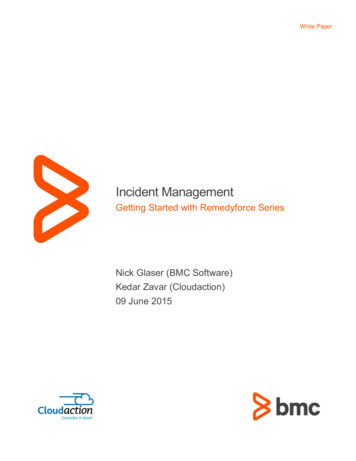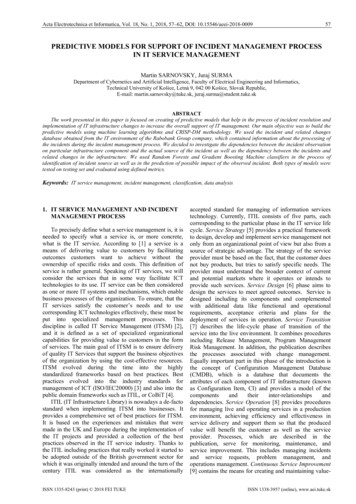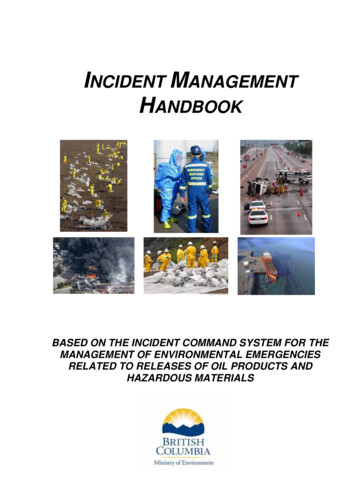
Transcription
INCIDENT MANAGEMENTHANDBOOKBASED ON THE INCIDENT COMMAND SYSTEM FOR THEMANAGEMENT OF ENVIRONMENTAL EMERGENCIESRELATED TO RELEASES OF OIL PRODUCTS ANDHAZARDOUS MATERIALS
Blank Page
PREAMBLEThe government of British Columbia uses the IncidentCommand System (ICS) for incident managementduring emergencies at the site (Incident CommandPost) and field (tactical) response levels. The ICS isthe foundation of the British Columbia EmergencyResponse Management System (BCERMS).This Incident Management Handbook (IMH) assiststhe Incident Management Team (IMT) personnel inthe delivery of the ICS. These members include thoseassigned to ICS positions, as well as, technicalspecialists (Chapter 4).The IMH serves as a reference guide. It supportsdelivery of provincial-level response plans preparedby the BC Ministry of Environment as the lead (key)provincial agency for spills of oil and hazardousmaterial releases. Other supporting resources forresponse plan delivery include operational guidelinesrelated to the delivery of the ICS, as well astechnically specific matters (Chapter 7).This IMH does not take the place of ICS training forresponders. It does not affect IMT memberauthorities. It is not a policy document. The IMHshould be read according to specific chapter(s) orpages that are relevant to the role/position being filledduring an exercise on an incident.i
Blank Pageii
BC EMERGENCY MANAGEMENT SYSTEMThe BC Emergency Management System (BCERMS)is an all-threat approach to the management ofemergencies in British Columbia. It is recognized asa standard system for emergency response, andcurrently mandated for use within the provincialgovernment and recommended to local authorities.BCERMS includes standardized emergencymanagement organizations, training requirements,technologies, forms, and more.The core of BCERMS is the international and provenIncident Command System that is applied at the site(Incident Command Post) and field (tactical) levels.The effective delivery of the ICS is the focus of thishandbook.iii
Blank Pageiv
BCERMS RESPONSE GOALS Provide for the safety and health of allresponders Save lives Reduce suffering Protect public health Protect government infrastructure Protect property Protect the environment Reduce economic and social lossesv
Blank Pagevi
THE BCERMS HIERARCHYvii
Blank Pageviii
THE INCIDENT COMMAND SYSTEMORGANIZATIONEnvironmentalUnitix
Blank Pagex
TABLE OF CONTENTSCOMMON RESPONSIBILITIES1CHAPTER 1 - INITIAL RESPONSE AND INCIDENT MANAGEMENT5OVERVIEW OF INITIAL RESPONSE PROCESSICS-201 INCIDENT BRIEFING FORM78INITIAL UNIFIED COMMAND MEETING10IC/UC OBJECTIVES MEETING12COMMON RESPONSE OBJECTIVES14COMMAND AND GENERAL STAFF MEETINGPREPARING FOR THE TACTICS MEETING1518PARTICIPANTS IN TACTICS MEETINGPREPARING FOR THE PLANNING MEETING2224MATERIALS AND DISPLAY FOR A PLANNING MEETINGPLANNING MEETINGOPERATIONS BRIEFING252735EXECUTE THE INCIDENT ACTION PLAN38SPECIAL PURPOSE MEETINGSBUSINESS MANAGEMENT MEETINGAGENCY REPRESENTATIVE MEETINGMEDIA BRIEFINGTECHNICAL SPECIALIST MEETING4141414242CHAPTER 2 - RESOURCE ORDERING, SITUATION DISPLAY, ANDFORMS43RESOURCE REQUEST AND ORDERING PROCESS43INCIDENT SITUATION DISPLAY46ICS FORMS47xi
CHAPTER 3 - ENVIRONMENTAL DATA MANAGEMENT BY THEENVIRONMENTAL UNITSCIENTIFIC COORDINATORS & TECHNICAL SPECIALISTS4950IMPLEMENTATION OF THE ENVIRONMENTAL UNIT51OPERATIONS AND PLANNING INTEROPERABILITY53CHAPTER 4 - CHECKLISTS FOR INCIDENT MANAGEMENT TEAMPOSITIONS55INCIDENT COMMANDER, COMMAND & GENERAL STAFFINCIDENT COMMANDERINFORMATION OFFICERLIAISON OFFICERSAFETY OFFICER5556586062GENERAL STAFF, BRANCH, AND UNIT POSITIONS65OPERATIONS SECTIONOPERATIONS SECTION CHIEFDEPUTY OPERATIONS SECTION CHIEF656668BRANCHES, DIVISIONS, AND RESOURCESOPERATIONS BRANCH DIRECTORDIVISION/GROUP SUPERVISORSTRIKE TEAM/TASK FORCE LEADER69707274STAGING MANAGER AND AIR OPERATIONS BRANCH DIRECTOR 75STAGING AREA MANAGER75AIR OPERATIONS BRANCH DIRECTOR77PLANNING SECTION AND UNITSPLANNING SECTION CHIEFRESOURCE UNIT LEADERSITUATION UNIT LEADERDEMOBILIZATION UNIT LEADERDOCUMENTATION UNIT LEADERENVIRONMENTAL UNIT LEADER80818385878990SPECIALIZED TASK POSITIONS WITHIN THE PLANNING SECTION 92CHECK-IN/STATUS RECORDER92DISPLAY PROCESSOR94xii
FIELD OBSERVER95TECHNICAL SPECIALISTSGEOGRAPHIC INFORMATION SYSTEM SPECIALISTDATA MANAGEMENT SPECIALISTWEATHER OBSERVERDOCUMENTATION SPECIALIST96969798100OTHER TECHNICAL SPECIALISTS (Mission & Tasks)RESPONSE TECHNOLOGY SPECIALISTSPUBLIC HEALTH TECHNICAL SPECIALISTLEGAL SPECIALIST101101102102LOGISTICS SECTION, BRANCHES AND UNITSLOGISTICS SECTION CHIEFSUPPORT BRANCH DIRECTORSUPPLY UNIT LEADERFACILITIES UNIT LEADERGROUND SUPPORT UNIT LEADERSERVICE BRANCH DIRECTORFOOD UNIT LEADERMEDICAL UNIT LEADERCOMMUNICATIONS UNIT STRATION SECTION, AND UNITSFINANCE/ADMINISTRATION SECTION CHIEFCOST UNIT LEADERCOMPENSATION/CLAIMS UNIT LEADERTIME UNIT LEADERPROCUREMENT UNIT LEADER118118120121121123CHAPTER 5 - UNIFIED COMMAND125CHAPTER 6 - AREA COMMAND129CHAPTER 7 – PROVINCIAL RESPONSE PLANS AND OPERATIONALGUIDELINES133OPERATIONAL GUIDELINES FOR ENVIRONMENTAL EMERGENCIES133FOR AN AGENCY EXECUTIVE/POLICY GROUP133xiii
FOR SUPPORT EMERGENCY OPERATIONS CENTRESFOR INCIDENT MANAGEMENTFOR SELECTED ICS POSITIONSFOR SPECIAL CENTRESFOR TECHNICAL – GENERALFOR TECHNICAL – HAZARD SPECIFIC133134134135135135xiv
COMMON RESPONSIBILITIESThe following are applicable to all personnelworking with an Incident Command System(ICS) organization: Receive: Job assignment; Reporting location; Reporting time; Travel instructions; Communications instructions.Review Incident Management Handbook (IMH)regarding positions and tasks specific toassignment. Check in at a designated location which maybe any of the following locations: Incident Command Post (ICP); Base or Camps; Staging Areas; Area Command Post. Receive briefing from immediate supervisor,and/or receive orientation briefing.1
Acquire work materials.Supervisors maintain accountability forassigned personnel with regard to workinglocation, and personnel safety and welfare atall times. They are responsible for briefings. Participate in meetings and briefings asdirected and be prepared with assignments. Ensure compliance with all safety practicesand procedures. Report unsafe conditions to the SafetyOfficer. Know your assigned communicationprocedures Ensure that communication equipment isoperating properly. Use clear text (no codes) and ICS terms inradio communications. Complete forms and reports required of theassigned position. Ensure proper disposition of incidentdocumentation as directed. Ensure all tactical and personnel protectionequipment are operational prior to eachwork period. Brief ongoing personnel when relieved. Return all assigned equipment toappropriate location.2
Complete demobilization check-out processbefore returning to home office. Respond to demobilization orders and briefstaff regarding demobilization. At shift changes, brief incoming staff andreceive briefing from outgoing staff. Maintain individual activity log records (ICS214).3
Blank Page4
CHAPTER 1 - INITIAL RESPONSE AND INCIDENTMANAGEMENTThere is always a period of initial response,assessment and management. Incidents thatare small in scope, complexity or duration canoften be coordinated using only the ICS 201Incident Briefing form and its process. Thisform is used by the first operational personnelon-scene to manage and track responseefforts. It is also used for the incoming IncidentCommander (IC) by providing a written recordof information on the incident situation and theresources allotted.The ICS begins with the designation of anIncident Commander.The ICS 201 continues to develop by the ICuntil the response ends or the first IncidentAction Plan (IAP) is generated.Should the incident escalate and becomecomplex and protracted, the IC will call for theICS planning process to commence andestablish an Operational Period (See Figure 1).Activation of specific meeting and products willthen commence to establish an IAP.5
OPERATIONALPERIOD FOR ONGOING RESPONSEMANAGEMENT ANDPLANNINGINITIAL ASSESSMENTAND RESPONSEMANAGEMENT UNTILINCIDENT CLOSURE ORWHEN ANOPERATIONAL PERIODHAS BEEN INVOKED BYCOMMAND.Figure 1: The Initial Response Phase and theOperational Period Planning Cycle6
OVERVIEW OF INITIAL RESPONSE PROCESS7
ICS-201 INCIDENT BRIEFING FORMAn incident briefing using the ICS 201 IncidentBriefing form facilitates response objectives,situational awareness, resource deployment,and documents actions.When: Arriving at the incident and establishingthe ICS by invoking an Incident Commander.Facilitator: Operations or IncidentCommander.General TasksIncident Commander Obtain incident briefusing ICS-201 IncidentBriefing Form fromoperational personnel. Assess situation andoperationalrequirements. Determinecurrent/futureorganizational andresponse requirementobjectives.Operations Assist in developingstrategies and tactics;and Assemble resources.Other ICS Sections: May not be activated atthis time.8
An initial incident briefing, using ICS 201Incident Briefing form includes:1. Current situation.2. Initial objectives and priorities.3. Current and planned actions.4. Current on-scene organization.5. Resource assignments.6. Resources en-route and/or ordered.7. Facilities established.8. Jurisdictions/organizations involved.9. Media interests.Next Step: Undertake an Unified Commandmeeting if more than one jurisdiction(federal, provincial, local governments,and/or First Nations), functionalemergency agencies (Fire, Police and/orAmbulance), and/or Responsible Party*are engaged.NOTE: The “Responsible Party” (RP) is responsible formanaging funding response and paying compensation fordamages. The term RP does not infer fault. For an oil spill orhazardous material release, the RP is maybe a pipeline,railway, vehicle, or facility owner/operator and represented byits Incident Commander.9
INITIAL UNIFIED COMMAND MEETINGProvides Unified Command (UC) anopportunity to discuss and concur on issuesprior to incident action planning. The meetingis brief and important matters documented.When: As soon as the UC is requestedFacilitator: Designated spokesperson for UCAttendees: Only ICs that will comprise the UC;reside at the command table. Recorders andadvisors can attend to support the UC.General TasksIncident Commander Determine need forUC; Negotiate UCparticipation andspokespersondesignation; Clarify UC roles &responsibilities; Agree on incidentname, responseorganization, facilities,and support; Determine OperationalPeriod length/starttime; and Determine OPS chief.10
Agenda for Unified Command Meeting:1. Identify jurisdictional priorities.2. Present jurisdictional limitations andconcerns.3. Designate Operations Section Chief andDeputy(s).4. Designate Command Staff.Agree on:1. Incident name.2. Spokesperson for UC3. Organization structure.4. Whether to establish an OperationalPeriod.5. Meeting schedules.6. Resource ordering procedures.7. Cost-sharing procedures.8. Sensitive information, intelligence, andoperational security matters.Next Step: Prepare for a meeting by commandto establish response objectives.11
IC/UC OBJECTIVES MEETINGThe IC, or an UC, identifies incident objectives.These objectives are reviewed and new onesare identified for each Operational Period asthe incident’s situation changes.When: Prior to Command and General StaffMeeting.Facilitator: IC/UC Member or PlanningSection Chief.Attendees: IC/UC Members; SelectedCommand and General Staff, DocumentationUnit Leader.General TasksCommand Develop incidentobjectives; and Prepare guidance forCommand andGeneral Staff (task).Operations May be present ifrequired.Planning Facilitate anddocument meeting;andPropose draftobjectives toCommand.12
Agenda for IC/UC Objectives Meeting:1. Planning Section Chief brings the IC/UCobjectives meeting to order, conducts rollcall, covers ground rules and reviewsagenda.2. Develop or review/select objectives.3. Develop tasks for command and generalstaff to accomplish.4. Revalidate previous decisions, priorities,and procedures.5. Review any open actions from previousmeetings.13
COMMON RESPONSE OBJECTIVESThe following are common response objectivesfor an oil spill or hazardous material release.They appear on the Incident Action Plan’s(IAP) front cover, as well as the ICS 202Incident Objectives form.Response objectives drive the overall directionof the incident’s management. They may beadded or modified for each operational periodas the situation changes.Either adopt, modify or add:ooooooooooooooEnsure the Safety Response PersonnelControl the Threat SourceReduce ExposuresManage a Coordinated Response EffortMaximize Public ProtectionMaximize Environmental ProtectionMaximize Infrastructure ProtectionSearch and Rescue Affected PublicRescue and Rehabilitate Injured AnimalsRemove Contaminates from Affected AreasMinimize Economic and Social ImpactsProtect Integrity of Incident Scene for InvestigationKeep Stakeholders and Public InformedManage Public/Political ExpectationsNext Step: Prepare for a command andgeneral staff meeting.14
COMMAND AND GENERAL STAFF MEETINGThe IC/UC presents decisions andmanagement direction to the command andgeneral staff to ensure understanding of theobjectives, priorities, procedures andassignments agreed on. Meeting covers anychanges in command’s direction, reviewsstatus of assigned tasks.When: Prior to tactics meetingFacilitator: Planning Section ChiefAttendees: Command and General Staff andSituation Unit Leader.Most ICS meetings are best done standing upwhich expedites decisions being made.15
General TasksCommand Review decisions,direction, objectives,priorities andprocedures; Present functional workassignments (tasks) tothe Command andGeneral Staff members;and Review status of workassignments fromprevious meetings.Operations Provide update oncurrent operations.Planning Facilitate and documentmeeting; Set up meeting room;and Ensure meeting isdocumented anddistribute meetingmaterials.Situation Unit Leader Provide update oncurrent situation andprojections.16
Agenda for Command and General StaffMeeting:1. Planning Section Chief brings meeting toorder, conducts roll call, covers groundrules and reviews agenda.2. Situation Unit Leader conducts situationstatus briefing.3. IC/UC:a.Re-states the response objectives(used as agenda items)b.Assigns functional tasks toCommand and General Staffmembers.4. Planning Section Chief facilitates opendiscussion to clarify priorities, objectives,assignments, issues, concerns and openactions/tasks.5. IC/UC provides closing comments andreiterates any changes in responseobjectives, strategies, organization,and/or assignments.Next Step: Prepare for a tactics meeting.17
PREPARING FOR THE TACTICS MEETINGDuring this phase of the Operational PlanningPeriod (OP), the Operations and Planningsections begin the work of preparing for theupcoming tactics meeting. They reviewincident situation, and scope out a range ofstrategies and tactics to meet them.An ICS 215 Operational Planning Worksheetform and ICS 207 Organization Chart form arecompleted for the next operational period.The Safety Officer develops the hazard riskanalysis and completes the ICS 215a IncidentAction Plan Safety Analysis form.The Planning and Operation Section Chiefsreview’s situation status information to assesswork progress against IAP objectives. ThePlanning Section Chief ensures that thematerial, information, resources are organized,accurate and timely.When: Prior to tactics meetingFacilitator: Planning Section Chief facilitatesprocessAttendees: None. This is a preparation period.18
General TasksOperations Develop strategies andtactics for eachoperationally orientedincident objective; Outline work assignmentsand required resources; Develop team organizationfor next operational period.Planning Facilitate process; Review incident objectives& agree on those that arethe responsibility of theOperations Section; Ensure TechnicalSpecialists are includedand prepared to contributeas appropriate; Present situationinformation and provideprojections.Safety Officer Begin to develop the ICS215a Incident Action PlanSafety Analysis form.19
TACTICS MEETINGThis short meeting (30 minutes or less) createsthe blueprint for tactical deployment during thenext operational period. The section chiefsdevelop primary and alternate strategies tomeet objectives for consideration at the nextplanning meeting.It is the responsibility of the Operations Sectionto define the tactical (detailed) responserequirements, where as it is the responsibilityof the Planning Section to coordinate with theoperations to support advanced tacticalplanning.When: Prior to Planning MeetingFacilitator: Planning Section Chief facilitates(as requested by Operations Section Chief)Attendees: Planning Section Chief,Operations Section Chief, Safety Officer,Logistics Section Chief, Resource Unit Leader,and Situation Unit Leader20
General TasksOperations Brief current operations; Present strategies, tacticsand resource needs usingICS 215 form; and Present OperationsSection’s Organization(Branches, Divisions &Groups). Provide Division map witharea designations noted.Planning Facilitate meeting; Present current situationand provide projections; Present resources status; Document meeting; and Set up meeting room.Safety Identify potential hazardsand recommend mitigationmeasures.Logistics Participate/contributelogistics information asnecessary; and Verify supportrequirements; and Prepare draft ICS-204.21
PARTICIPANTS IN TACTICS MEETING22
Agenda for Tactics Meeting:1. Planning Section Chief brings meeting toorder, conducts roll call, covers ground rulesand reviews agenda.2. Situational Unit Leader reviews the currentand projected incident situation.3. Planning Section Chief reviews incidentoperational objectives, and ensuresaccountability for each one.4. Operations Section Chief reviews strategyand tactics as provided in the ICS 215Operational Planning Worksheet form.5. Operations Section Chief reviews ICS 207Organization Chart from an operationalperspective.6. Operations and Planning Section chiefsreview Division map to ensure correctannotations,7. Safety Officer identifies and resolves anysafety issues.8. Logistics Section Chief discusses andresolves any logistics issues.Next Step: Prepare for a planning meeting23
PREPARING FOR THE PLANNING MEETINGAll section chiefs and associated teammembers work on preparing for a planningmeeting. Each section chief is responsible forensuring that responsibilities and deliverablesare ready for this meeting.When: After the tactics meeting and prior tothe planning meetingFacilitator: All section chiefs ensures theprocess continues between meetingsAttendees: None. This is a preparation period.24
MATERIALS AND DISPLAY FORA PLANNING MEETING25
General TasksIncident Command Provide guidance/clarification; Monitor operations;Operations Work with Planning SectionChief and Resource UnitLeader to develop final ofICS 215 OperationalPlanning Worksheet.Planning Publish/distribute meetingschedule and ensureattendees know roles; Assist in preparing the ICS215 (including resources).Logistics Verify supportrequirements; and Consider and order supportrequirements.Finance/Admin Verify financial andadministrativerequirements.26
PLANNING MEETINGThis meeting should last no longer than 45minute to identify and solves problems, assesssafety hazards, and develop work assignmentsand responsibilities on an ICS 215 OperationsPlanning Worksheet form. Displays shouldincluded: ICS-202 Objectives form for the nextOperational Period, large sketch maps orcharts if incident area, ICS 215a IncidentAction Plan Safety Analysis form; resourceinventory by the Resource Unit, and situationstatus displays by the Situation Unit.This meeting provides the opportunity todiscuss and resolve any issues and concernsprior to assembling the Incident Action Plan.After review and updates are made, planningmeeting attendees commit to support the plan.When: After the UC and tactics meetingsFacilitator: Planning Section ChiefAttendees: Determined by IC/UC, generallyIC/UC, Command Staff, Safety Officer,General Staff, Air Operations Branch Director(Air Ops), the Resource Unit Leader, SituationUnit Leader, and Technical Specialists, asrequired.27
General TasksCommand Provide direction andresolve differences; Give approval of theproposed plan; Discuss and resolve anysafety, liaison, or mediaconsiderations and issues.Operations Provide overview of currentoperations; Present plan of actionincluding: strategies,tactics, contingencies,resources, organizationstructure and overallmanagementconsiderations.Planning Brief present situation; Provide threat and impactprojections; Address responsecoordination issues asneeded; gain consensus.Logistics Brief logistical support andresource ordering status.Finance/Admin Brief administrative andfinancial status/projections.28
Agenda for the Planning Meeting:1. IC/UC provides opening remarks.2. Planning Section Chief calls meeting,conducts roll call, covers ground rules andreviews agenda.3. Situational Unit Leader provides briefing oncurrent situation, resources at risk, weatherforecast, and incident projections.4. Planning Section Chief reviews Command’sincident objectives, priorities, decisions, anddirection.5. Operations Section Chief provides briefingon current operations followed with anoverview on the proposed plan includingstrategy, tactics/work assignments, resourcecommitment, contingencies, OperationsSection organizational structure, andneeded support facilities.6. Planning Section Chief reviews proposedplan to ensure that Command’s direction,priorities, and objectives are met.7. Planning Section Chief solicits final inputand commitment to the proposed plan fromCommand and General Staff.29
8. Planning Section Chief requestsCommand’s approval of the plan aspresented.9. Planning Section Chief issues assignmentsto appropriate team members for developingIncident Action Plan support documentation,such as special plans, along with deadlines.30
INCIDENT ACTION PLAN (IAP) PREPARATIONAND APPROVALPlanning meeting attendees, technicalspecialists, unit leaders and their staff prepareassignments for the IAP to meet the PlanningSection Chief’s deadline for assembling theIAP components (maps, assignments, weatherreports, sensitivity analysis, special plans, etc.)The deadline will be early to permit timelyIC/UC approval and duplication of sufficientcopies for the Operations Briefing.When: Immediately following the planningmeeting, the Planning Section Chief assignsthe deadline for productsFacilitator: Planning Section Chief ensuresthe process continues between meetingsAttendees: None. This is a preparation period.31
General TasksIncident Commander (IC/UC) Review, approve and signIAP when submitted.Operations Provide requiredinformation for inclusioninto IAP; Communicate incidentstatus changes; Work with Planning Sectionto ensure that ICS 204(s)assignments are complete.Planning Facilitate General Staff’sIAP input; Ensure assignments andexpectations are clear; Provide completed IAP toIC/UC for review/approval; Copies and distributescompleted IAP.Logistics Provide logisticsinformation for IAP; Verify resources ordered.Finance/Admin Verify financial andadministrativerequirements for IAP.32
Components of an IAP:1. Incident Objectives (ICS Form 202):Resource Unit2. Organization List/Chart (ICS Forms203/207): Resource Unit3. Assignment List (ICS Form 204): ResourceUnit4. Communication Plan (ICS Form 205):Communications Unit5. Medical Plan (ICS Form 206): Medical Unit6. Incident Map: Situation Unit7. Weather Forecast:* Situation Unit8. Safety Plan: Safety Officer9. Decontamination Plan (A special plan)**:Technical Specialist10. Waste Management Plan (A special plan):Technical Specialist11. Demobilization Plan: Demobilization Unit12. Air Operations Summary (ICS form 220):Operations Branch Director13. Traffic Plan Ground: Support Unit33
* Other forecasts, depending on workingenvironments can be river flood, coastal tidal,current and sea conditions.** Other special plans, depending on theincident needs and organization underOperations (Branches), can be: wildlife rescue,salvage, shore protection.Next Step: Prepare for an operations briefing.34
OPERATIONS BRIEFINGThis briefing presents the IAP to theOperations Section incoming supervisors(Division and/or Group). After this briefing,supervisors being relieved should beinterviewed by their relief to validate previousIAP’s effectiveness. The supervisor may makelast minute adjustments to tactics and mayreallocate resources within their Division/Groupto adapt to changing conditions.When: About an hour prior to each shiftchangeFacilitator: Planning Section ChiefAttendees: IC/UC, Command Staff, GeneralStaff, Branch Directors, Division/GroupSupervisors, Task Force/Strike Team Leaders(if possible), Unit Leaders, others asappropriate.35
General TasksIncident Command (IC/UC) Provide guidance/clarification; Provide leadershippresence.Operations Provide OperationsBriefing for nextoperational period; Ensure ICS 204assignments are clear.Planning Set up briefing area; Facilitate Command andGeneral Staff andattendees briefingresponsibilities; Resolve questions.Logistics Brief any transportation,communication, and supplyissues.Finance/Admin Brief administrative issuesand provides financialreport.36
Agenda for Operations Briefing:1. Planning Section Chief opens briefing,covers ground rules, agenda, and takesroll call of Command and General Staffand operations personnel required toattend.2. Planning Section Chief reviews IC/UCobjectives and any changes to the IAP.3. IC/UC provides remarks.4. Situation Unit Leader conducts SituationBriefing.5. Operations personnel discuss currentresponse actions and accomplishments.6. Operations Section Chief briefsDivision/Group supervisors.7. Logistics Section Chief covers transport,communications, and supply updates.8. Finance/Administration Section Chiefcovers fiscal issues.9. Safety Officer covers safety issues,Information Officer covers public affairsand public information issues, and LiaisonOfficer covers interagency issues.10. Planning Section Chief solicits finalcomments and adjourns briefing.37
EXECUTE THE INCIDENT ACTION PLANThe IAP is executed after the OperationalBriefing. This either occurs morning of theoperational period dated on the IAP, or may beprovided the evening before.A NEW OPERATIONAL PERIOD BEGINS!THE PLANNING PROCESS COMMENCESAGAIN!38
ASSESS PROGRESSAssessment is an ongoing to adjust currentoperations and plan for future change as theincident’s situation unfolds.Following the briefing, and shift change, allcommand and general staff, and section chiefswill review the incident response progress andmake recommendations to the IC/UC inpreparation for the next IC/UC ObjectivesMeeting.The IC/UC maintains close coordination withtheir respective supporting EmergencyOperation Centers, as well as their respectivePolicy Group (Agency Executive)* forsituational updates.* In industry, this group is often referred to as the “CrisisManagement Team” headed by a company’s Chief ExecutiveOfficer.39
General TasksIncident Commander(IC/UC) Monitor ongoing incidentmanagement activities;and Evaluate prior decisions,direction, priorities, andtask assignments.Operations (OPS) Monitor on-goingoperations and maketactical changes asnecessary; Measure/ensure progressagainst assignedobjectives; Brief command on ascheduled basis.Planning Ensure on-goingoperational information isbeing collected anddocumented; and Develop new/revisedincident objectives andprovide to IC/UC.Logistics Evaluate logisticalsupport effectivenessand make organizationaland proceduraladjustments as needed.Finance/Admin Monitor ongoingoperations to ensureaccurate and timelyadministrative andfinancial reporting.Safety Officer Monitor ongoingoperations and correctunsafe practices.40
SPECIAL PURPOSE MEETINGSSpecial purpose meetings are most applicableto larger incidents requiring an OperationalPeriod planning cycle, but may be usefulduring Initial response and assessment.BUSINESS MANAGEMENT MEETINGThis meeting develops and updates theoperating plan for finance and logisticalsupport. The agenda could include:documentation issues, cost sharing, costanalysis, finance requirements, resourceprocurement, and financial summary data.Attendees normally include: Cost Unit Leader,Logistics Section Chief, Situation Unit Leader,Resource Unit Leader.AGENCY REPRESENTATIVE MEETINGThis meeting is held to update AgencyRepresentatives and ensure that they cansupport the IAP. It is conducted by the LiaisonOfficer, and attended by AgencyRepresentatives. It is most appropriately heldafter the Planning Meeting to announce plansfor the next operational period. It allows forminor changes should the plan not meet theexpectations of the Agency Representatives.41
MEDIA BRIEFINGThis meeting briefs media and the public onthe most current and accurate facts. It is set upand moderated by the Information Officer, andfeatures selected spokespersons. This briefmust be held away from the IncidentCommand Post, and is normally conducted ata Joint Information Center (JIC).Spokespersons should be prepared by theInformation Officer to address anticipatedissues. The briefing should be well-planned,organized, and scheduled to meet the media’sneeds.TECHNICAL SPECIALIST MEETINGMeetings may be held to gather technicalspecialist’s input to IAP. As an example, theEnvironmental Unit Leader may call togetherTechnical Specialists to review proposedtactics for the IAP to assess the efficacy toprotect people, property or the envi
The government of British Columbia uses the Incident Command System (ICS) for incident management during emergencies at the site (Incident Command Post) and field (tactical) response levels. The ICS is the foundation of the British Columbia Emergency Response Management System (BCERMS). This Incident Management Handbook (IMH) assists
